It looks like you're using an Ad Blocker.
Please white-list or disable AboveTopSecret.com in your ad-blocking tool.
Thank you.
Some features of ATS will be disabled while you continue to use an ad-blocker.
share:
Why haven't they collected a sample of the water to analyze whats in it, that might give them a clue as to the source?
reply to post by ZeroReady
I have been trying to find some info regarding if its still running, and if so is the volume the same or is it slowing down, but haven't found anything as of yet.
Would be very interesting if you can check. I will keep looking
I have been trying to find some info regarding if its still running, and if so is the volume the same or is it slowing down, but haven't found anything as of yet.
Would be very interesting if you can check. I will keep looking
reply to post by Isolation
Looks like "grey water":
en.wikipedia.org...
Greywater gets its name from its cloudy appearance and from its status as being between fresh, potable water (known as "white water") and sewage water ("black water"). In a household context, greywater is the leftover water from baths, showers, hand basins and washing machines only. Some definitions of greywater include water from the kitchen sink. Any water containing human waste is considered black water.
Elimination of greywater
Domestic wastewater is usually combined at the sewer, so that grey- and blackwaters are removed together using a shared sewerage system in a process called elimination.
Sewage water can then be treated to limit pollution and health risks, before being returned to the environment at large. Most greywater ends up as effluent in rivers and oceans in this way.
--------------------------------------------------------------------------------------
So if you think about all of the hotels that surround the harbour...where else are they going to dispose of all of their grey water??? I am not surprised they haven't been called out on this one yet...bet you I will be right...just wait and see
Looks like "grey water":
en.wikipedia.org...
Greywater is wastewater generated from domestic activities such as laundry, dishwashing, and bathing, which can be recycled on-site for uses such as landscape irrigation and constructed wetlands. Greywater differs from water from the toilets which is designated sewage or blackwater to indicate it contains human waste.
Definition
Greywater gets its name from its cloudy appearance and from its status as being between fresh, potable water (known as "white water") and sewage water ("black water"). In a household context, greywater is the leftover water from baths, showers, hand basins and washing machines only. Some definitions of greywater include water from the kitchen sink. Any water containing human waste is considered black water.
Elimination of greywater
Domestic wastewater is usually combined at the sewer, so that grey- and blackwaters are removed together using a shared sewerage system in a process called elimination.
Sewage water can then be treated to limit pollution and health risks, before being returned to the environment at large. Most greywater ends up as effluent in rivers and oceans in this way.
--------------------------------------------------------------------------------------
So if you think about all of the hotels that surround the harbour...where else are they going to dispose of all of their grey water??? I am not surprised they haven't been called out on this one yet...bet you I will be right...just wait and see
edit on 2-3-2012 by
Skywatcher2011 because: (no reason given)
reply to post by Skywatcher2011
I think Skywatcher is probably on the right track. There are an awful lot of people on Oahu, lots of large buildings, plenty of underground water pipes.
More than likely a waste water pipe broke and is discharging through the drain in to the harbor. I can't imagine any volcanic activity on the Big Island would be the cause, probably just an overloaded sewer system.
I think Skywatcher is probably on the right track. There are an awful lot of people on Oahu, lots of large buildings, plenty of underground water pipes.
More than likely a waste water pipe broke and is discharging through the drain in to the harbor. I can't imagine any volcanic activity on the Big Island would be the cause, probably just an overloaded sewer system.
reply to post by VariableConstant
It's possible it could be a sewer break . It just seemed a large volume of water
It could be a surface waste pipe or grey water pipe that has broken and accumulated behind a blockage which finaly gave way as Phage said - I suppose the best indicator of that is if the flow slows down.
If it dosn't slow and no source can be identified I suppose we will have to wait for the test results.
*edit*
I suppose it could also be a stream that has some how re routed into the storm drain (maybe a sink hole) but not sure how that explains the milky brown colour (if it is still milky brown and hasn't cleared).
It's possible it could be a sewer break . It just seemed a large volume of water
It could be a surface waste pipe or grey water pipe that has broken and accumulated behind a blockage which finaly gave way as Phage said - I suppose the best indicator of that is if the flow slows down.
If it dosn't slow and no source can be identified I suppose we will have to wait for the test results.
*edit*
I suppose it could also be a stream that has some how re routed into the storm drain (maybe a sink hole) but not sure how that explains the milky brown colour (if it is still milky brown and hasn't cleared).
edit on 2-3-2012 by Isolation because: afterthought
edit on 2-3-2012 by Isolation because: (no reason given)
reply to post by Isolation
This may not be entirely correct, as I've never really looked in to it, but I was living on Oahu for a bit several years ago, and I recall hearing that a lot of land was actually artificially built up on coral that was dredged from offshore.
So here's a scary thought: what if a large section of underground pipe has broken, and the water is eroding the substrate, washing out the silt and creating a hollow space that would eventually open up a sinkhole?
Hopefully the cause is something more benign, but I'd say it is a possibility.
This may not be entirely correct, as I've never really looked in to it, but I was living on Oahu for a bit several years ago, and I recall hearing that a lot of land was actually artificially built up on coral that was dredged from offshore.
So here's a scary thought: what if a large section of underground pipe has broken, and the water is eroding the substrate, washing out the silt and creating a hollow space that would eventually open up a sinkhole?
Hopefully the cause is something more benign, but I'd say it is a possibility.
Originally posted by Missing Blue Sky
Why haven't they collected a sample of the water to analyze whats in it, that might give them a clue as to the source?
If I recall correctly, I saw someone carrying collection containers in the video. Can't rewatch it where I am at to confirm this though.
reply to post by VariableConstant
I was wondering why the original artical mentioned that the officials thought the silt was coral, couldn't understand how that came in contact with fresh water in such large quantities.
I've found another article with more information on the current flow rate and colour.
It states that as of Thursday the flow was just as steady but not as thick and milky as it was on Wednesday
Link
It also says the officials are looking upstream so maybe it is a rouge river / stream via a sinkhole ?
I was wondering why the original artical mentioned that the officials thought the silt was coral, couldn't understand how that came in contact with fresh water in such large quantities.
I've found another article with more information on the current flow rate and colour.
It states that as of Thursday the flow was just as steady but not as thick and milky as it was on Wednesday
Link
It also says the officials are looking upstream so maybe it is a rouge river / stream via a sinkhole ?
Originally posted by VariableConstant
reply to post by Skywatcher2011
I think Skywatcher is probably on the right track. There are an awful lot of people on Oahu, lots of large buildings, plenty of underground water pipes.
More than likely a waste water pipe broke and is discharging through the drain in to the harbor. I can't imagine any volcanic activity on the Big Island would be the cause, probably just an overloaded sewer system.
But I thought they brought in experts who ruled that out?
Waste water would not be that hard to identify unless not-a-one is competent among that investigatory crew!
I can't see that.
Originally posted by Missing Blue Sky
Why haven't they collected a sample of the water to analyze whats in it, that might give them a clue as to the source?
I (we?) assumed they have. If not, what the heck are they there for? To gaze at it?
I don't get the impression this was waste or a known discharge of any kind. I heard on that video they ruled that out.
reply to post by Isolation
Much of Honolulu is built on ancient coral reefs. Very porous.
www.caves.org...
Much of Honolulu is built on ancient coral reefs. Very porous.
Westward toward and beyond the latter, buried or surficial reef limestone extends many kilometers, to and beyond Pearl Harbor, where Ford Island is entirely calcareous (Stearns1939). Romantic journalism (e.g., Williams 1935) refers to “miles and miles” of caves here. Although considerable artesian water has been obtained by drilling, a few long drained ponds are the only karstic features known to have existed
between the Moiliili Karst and Pearl Harbor.
www.caves.org...
reply to post by Isolation
they mentioned that the storm drain connects with a artisian well further inland ,
if thats the case then it could be possible that the artisian well is fed by an aquifier and somehow is now over feeding the well causing it to overflow into the storm drain .
they mentioned that the storm drain connects with a artisian well further inland ,
if thats the case then it could be possible that the artisian well is fed by an aquifier and somehow is now over feeding the well causing it to overflow into the storm drain .
i highly doubt it's waste water. that would smell and they all say it doesn't smell. they would KNOW if it was waste water.
reply to post by Isolation
The fact they do not know what it is and I heard no mention of samples taken and sent to a lab for analysis is strange. This would have been one of the first things I would have ordered if in charge . They also mentioned it was part of a deep well as its origin , I would have taken samples there also .
If I had to guess I would say it has to do with volcanic activity in the area . There has not been enough analysis done at this point to make a real educated guess .
The fact they do not know what it is and I heard no mention of samples taken and sent to a lab for analysis is strange. This would have been one of the first things I would have ordered if in charge . They also mentioned it was part of a deep well as its origin , I would have taken samples there also .
If I had to guess I would say it has to do with volcanic activity in the area . There has not been enough analysis done at this point to make a real educated guess .
I just got back from the harbor. Took some pics and video of the storm drain in question. It's definitely still spewing cloudy water. When I got
there, the harbormaster from the news video was there looking at the drain too. I started taking pictures, and he asked me what business I had in the
harbor. It was obvious he didn't want me there. I told him I'd seen the story about the storm drain on the news and I wanted to come check it out to
see if it was still spewing murky water into the ocean, because I care about the environment and I get worried when unknown crap is flowing into the
ocean.
He said the pictures on the web were fine, and I didn't need to take anymore. I told him they aren't fine because they're 2 days old. If the stuff has been coming out of the drain for 2 days, at the rate I saw it flowing, then there is a lot of whatever it is.
I asked him if they knew what it was yet and he said they're still running tests. They know it's fresh water, not salt. They know it is not gray water from hotels. They shut off the flow from the artisan well nearby, and they stuff is still coming out. So it isn't from the well either.
It's interesting you brought this up, because the harbormaster said the best theory right now is that it's crushed up coral. I was about to ask why crushed coral was flowing into the ocean, and where it was coming from, then he just got into a car and left all of a sudden. I felt like he was being kind of weird. Maybe he was just stressed out from dealing with a possible environmental problem in his harbor.
So the first pic is from right near the storm drain itself. There are no fish around.
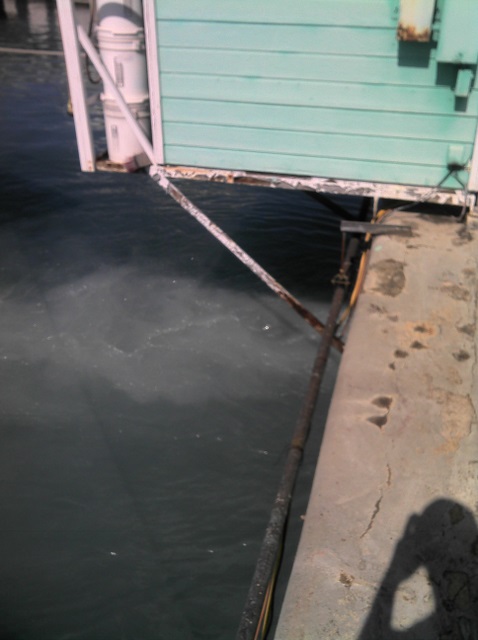
Next is slightly downstream from the drain. The water is completely opaque. Still no fish.
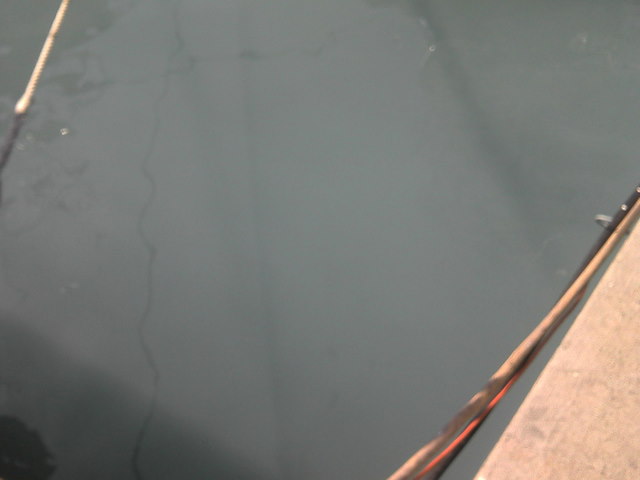
Third is a little further away. You can see a few inches into the water and there are a couple fish in the area.
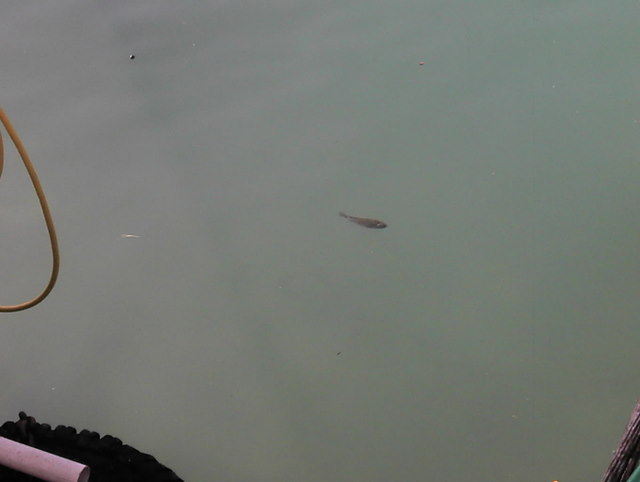
Fourth is even further. The water is much clearer and there are lots of fish around going about their business.
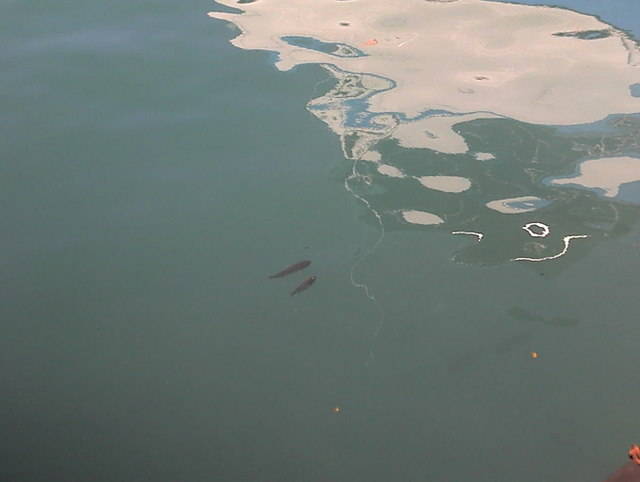
And the warning signs are still up.
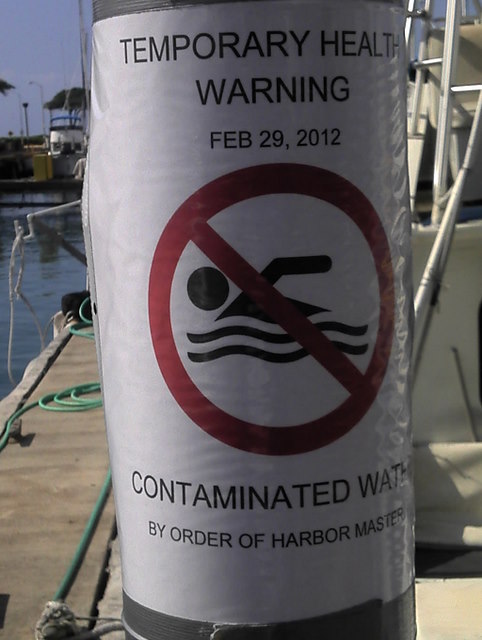
Here's a quick video I took, just to show how fast it's flowing.
I know it's hard to tell from the pics, but away from the storm drain the water is remarkably clear for harbor water. You can see the bottom. There are lots and lots of fish, as there should be, away from the drain. Closer to the drain, no fish.
It's been flowing for at least 2 days now, and they're still running tests to see what it is. That sounds fishy to me, because we have some of the foremost marine science facilities in the world right here in Hawaii. It would seem to me that they ought to be able to tell right away what the stuff is. But they really have no clue.
I'm going with the crushed coral theory I guess. Just hope no sinkholes open up.
He said the pictures on the web were fine, and I didn't need to take anymore. I told him they aren't fine because they're 2 days old. If the stuff has been coming out of the drain for 2 days, at the rate I saw it flowing, then there is a lot of whatever it is.
I asked him if they knew what it was yet and he said they're still running tests. They know it's fresh water, not salt. They know it is not gray water from hotels. They shut off the flow from the artisan well nearby, and they stuff is still coming out. So it isn't from the well either.
Originally posted by VariableConstant
reply to post by Isolation
This may not be entirely correct, as I've never really looked in to it, but I was living on Oahu for a bit several years ago, and I recall hearing that a lot of land was actually artificially built up on coral that was dredged from offshore.
So here's a scary thought: what if a large section of underground pipe has broken, and the water is eroding the substrate, washing out the silt and creating a hollow space that would eventually open up a sinkhole?
Hopefully the cause is something more benign, but I'd say it is a possibility.
It's interesting you brought this up, because the harbormaster said the best theory right now is that it's crushed up coral. I was about to ask why crushed coral was flowing into the ocean, and where it was coming from, then he just got into a car and left all of a sudden. I felt like he was being kind of weird. Maybe he was just stressed out from dealing with a possible environmental problem in his harbor.
So the first pic is from right near the storm drain itself. There are no fish around.

Next is slightly downstream from the drain. The water is completely opaque. Still no fish.

Third is a little further away. You can see a few inches into the water and there are a couple fish in the area.

Fourth is even further. The water is much clearer and there are lots of fish around going about their business.

And the warning signs are still up.

Here's a quick video I took, just to show how fast it's flowing.
I know it's hard to tell from the pics, but away from the storm drain the water is remarkably clear for harbor water. You can see the bottom. There are lots and lots of fish, as there should be, away from the drain. Closer to the drain, no fish.
It's been flowing for at least 2 days now, and they're still running tests to see what it is. That sounds fishy to me, because we have some of the foremost marine science facilities in the world right here in Hawaii. It would seem to me that they ought to be able to tell right away what the stuff is. But they really have no clue.
I'm going with the crushed coral theory I guess. Just hope no sinkholes open up.
reply to post by Phage
Interesting PDF. There seems to have been a lot of sink holes and subsidences over the years changing water levels and flows.
Interesting PDF. There seems to have been a lot of sink holes and subsidences over the years changing water levels and flows.
Originally posted by windword
An explosion on the Big Island of Hawaii, maybe someone's propane tank or meth lab blew, could have NO effect on Oahu's water table. They are way to far apart and are not connected geothermally either.
Yeah, a meth lab. What?
reply to post by ZeroReady
Excellent pics and video , shows the flow well.
if its been flowing like that for two days thats a lot of water
Appreciate you going down there to film this
Excellent pics and video , shows the flow well.
if its been flowing like that for two days thats a lot of water
Appreciate you going down there to film this
new topics
-
To become president, Zelensky had to learn Ukrainian
Political Conspiracies: 5 hours ago -
Green Grapes
General Chit Chat: 9 hours ago
top topics
-
S.C. Jack Smith's Final Report Says Trump Leads a Major Conspiratorial Criminal Organization!.
Political Conspiracies: 16 hours ago, 11 flags -
Advice for any young Adult .
General Chit Chat: 17 hours ago, 10 flags -
Green Grapes
General Chit Chat: 9 hours ago, 6 flags -
To become president, Zelensky had to learn Ukrainian
Political Conspiracies: 5 hours ago, 5 flags -
Those Great Fresh Pet Commercials
Television: 14 hours ago, 3 flags
active topics
-
To become president, Zelensky had to learn Ukrainian
Political Conspiracies • 5 • : Dalamax -
Los Angeles brush fires latest: 2 blazes threaten structures, prompt evacuations
Mainstream News • 120 • : Lazy88 -
Gravitic Propulsion--What IF the US and China Really Have it?
General Conspiracies • 37 • : Lazy88 -
The Truth about Migrant Crime in Britain.
Social Issues and Civil Unrest • 34 • : angelchemuel -
Russia Ukraine Update Thread - part 3
World War Three • 6905 • : Arbitrageur -
Planned Civil War In Britain May Be Triggered Soon
Social Issues and Civil Unrest • 22 • : Freeborn -
Labour Plotting to Postpone May's Council Elections ?
Regional Politics • 21 • : angelchemuel -
What Comes After January 20th
Mainstream News • 34 • : charlest2 -
Some sausage, some chicken, some sauce, some onions and some garlic...and some peppers!
Food and Cooking • 4 • : putnam6 -
S.C. Jack Smith's Final Report Says Trump Leads a Major Conspiratorial Criminal Organization!.
Political Conspiracies • 42 • : WeMustCare
